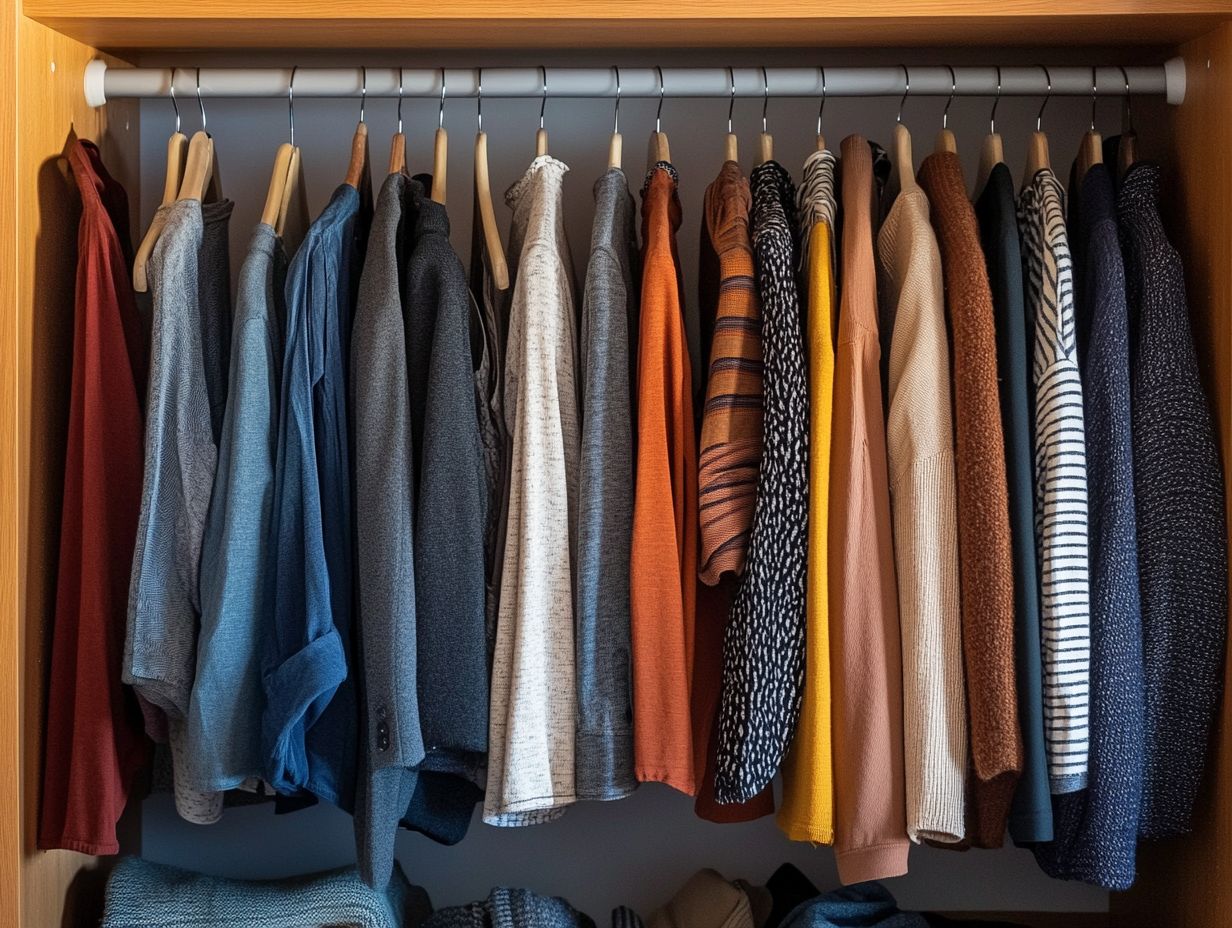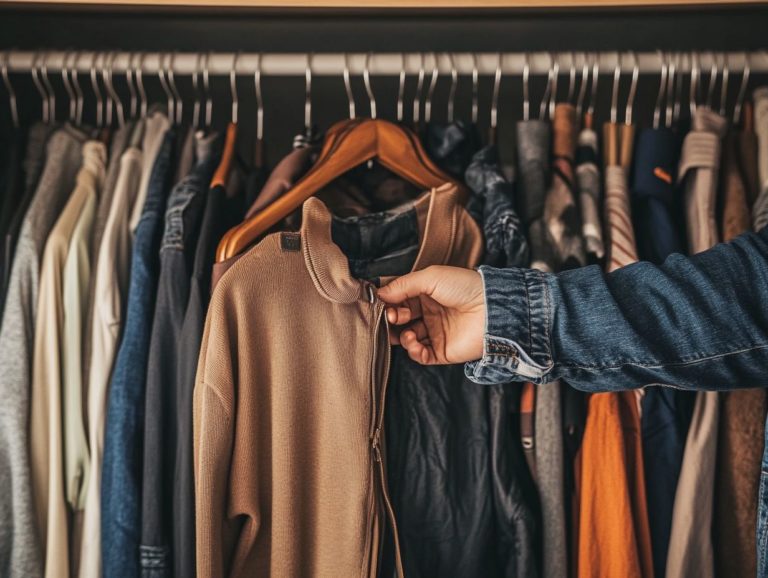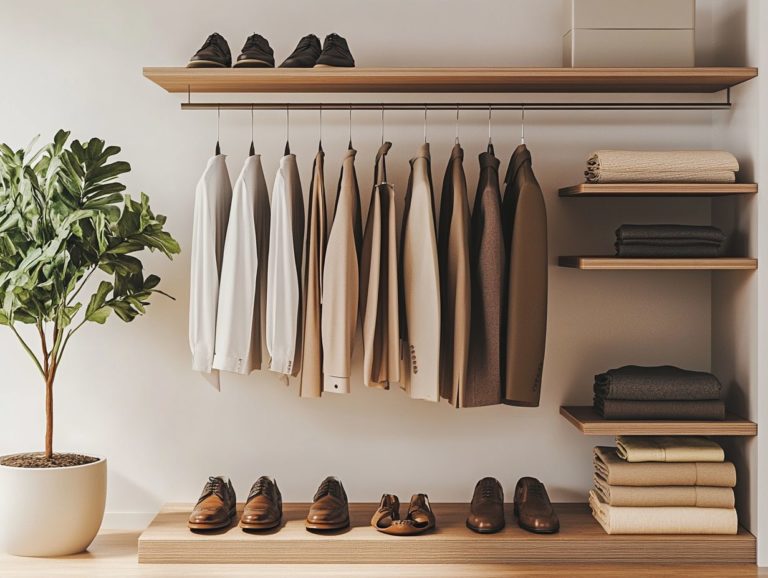What is the 30 Wear Rule?
In a world that increasingly values sustainability and conscious consumption, the 30 Wear Rule stands out as a guiding principle for your fashion choices in the realm of sustainable fashion.
This rule invites you to assess your wardrobe by contemplating whether you can wear an item at least 30 times before deeming it a worthwhile purchase.
Discover the essence of the 30 Wear Rule. Explore its benefits, including positive environmental impacts and cost savings. Get practical tips for incorporating it into your daily life with ethical brands and sustainable choices.
We will also look at when it s okay to bend the rules and how to maximize the potential of your clothing without resorting to discarding, especially through clothing care and repair services.
Start your journey today!
Contents
Key Takeaways:
Here are the essential points to remember about the 30 Wear Rule:

- The 30 Wear Rule encourages wearing each item in your wardrobe at least 30 times before discarding it, promoting sustainability and reducing waste.
- Following the 30 Wear Rule can benefit the environment, your wallet, and the quality of your wardrobe.
- To implement the 30 Wear Rule, keep track of wears and find creative ways to style and repurpose clothing, with exceptions for items that are damaged or no longer fit.
Understanding the 30 Wear Rule
The 30 Wear Rule is a crucial principle in sustainable fashion that invites you to promise to wear a piece of clothing at least 30 times before considering discarding it. This approach tackles the pressing issue of waste from clothing that plagues the fast fashion (the rapid production of cheap clothing) industry.
By embracing this guideline, you begin to appreciate how long your clothes last, prompting a reevaluation of your buying habits. It encourages you to prioritize quality over quantity in your wardrobe management, ultimately fostering responsible shopping behaviors and consumer responsibility.
Adopting the 30 Wear Rule allows you to contribute significantly to a more sustainable fashion landscape, reduce clothing emissions (the environmental impact caused by clothing production and disposal), and make choices that reflect your personal style while engaging in vintage shopping and secondhand clothes.
What is the 30 Wear Rule?
The 30 Wear Rule suggests that you should wear clothing at least 30 times to justify its purchase. This encourages a thoughtful approach to your fashion consumption.
This principle arose in response to the negative impacts of fast fashion, which frequently leads to excessive waste and environmental harm. By adopting this mindset, you are prompted to consider the longevity and quality of your garments rather than chasing fleeting trends.
The significance of this rule lies in its power to inspire sustainable choices, urging you to invest in durable pieces that can truly stand the test of time and promote fashion sustainability. Understanding the lifecycle of clothing becomes essential, as it promotes conscious decision-making regarding production practices, resource usage, and eventual disposal, aligning with the goals of slow fashion. In doing so, you advocate for a more responsible and ethical fashion industry.
Benefits of Following the 30 Wear Rule
By embracing the 30 Wear Rule, you unlock a multitude of benefits. Not only do you significantly reduce your environmental footprint, but you also enjoy substantial cost savings.
This approach fosters a deeper appreciation for quality and versatility in your clothing choices, ultimately leading to a more sustainable wardrobe filled with ethical brands and fashion impact.
Environmental Impact
The environmental impact of embracing the 30 Wear Rule is significant. It also contributes to fashion sustainability by fostering a circular economy, emphasizing the importance of slow fashion.
When you commit to wearing each garment at least thirty times, you make a powerful statement! You actively reduce the demand for fast fashion, which is infamous for its resource-intensive production processes and substantial emissions, reflecting the values promoted by Eco Age and Livia Firth.
Adopting the 30 Wear Rule encourages responsible consumption, where you prioritize quality over quantity. This mindful approach minimizes the textile waste that ends up in landfills and promotes the recycling and repurposing of fabrics, ultimately nurturing a flourishing circular economy, a key tenet of sustainable initiatives.
By integrating such practices into your wardrobe choices, you help mitigate the environmental footprint of your clothing, paving the way for a more sustainable future in fashion while keeping track of fashion statistics.
Cost Savings

One of the remarkable advantages of the 30 Wear Rule lies in the substantial cost savings it offers! It prompts you to rethink your shopping habits and prioritize quality over quantity through denim items and ethical fashion brands.
By concentrating on versatile, durable pieces that stand the test of time and can be worn on various occasions, you can significantly reduce the expenses typically linked to fast fashion. This mindful approach not only elevates your wardrobe but also promotes a more sustainable lifestyle, minimizing waste and lowering your environmental footprint.
When you prioritize garments that provide lasting value instead of opting for cheap, trendy items, you naturally cut down on your overall spending. Embracing this principle aligns your personal finance goals with eco-friendly choices, demonstrating that smart shopping can yield both financial benefits and a positive impact on the planet.
Quality and Versatility
Embracing the 30 Wear Rule allows you to focus on quality and versatility, leading to a more effective management of your wardrobe while nurturing an appreciation for ethical brands and the idea of shopping responsibly.
By committing to the principle that each clothing item should be worn at least 30 times, you can cultivate a minimalist wardrobe that highlights durable materials and timeless designs. This philosophy not only helps reduce clutter but also enables you to make mindful choices, favoring brands that prioritize ethical production practices.
When you select versatile garments that effortlessly transition from casual outings to formal occasions, such as rental services for special attire, you ll find yourself owning fewer items, yet each one is of higher quality. Ultimately, this approach supports a sustainable fashion industry and aligns with your personal values, fostering a deeper connection to every piece in your collection.
How to Implement the 30 Wear Rule
Ready to start the 30 Wear Rule? Here s how you can do it now! You must adopt a proactive mindset that revolves around meticulously tracking your wears, managing your wardrobe responsibly, and mastering the art of clothing care through clothing measurement and size recommendations.
This approach will not only help you extend the lifecycle of your garments but also elevate your overall style experience.
Tips for Tracking Wears
Tracking your wardrobe wear can be achieved through various methods, such as keeping a dedicated log or utilizing mobile apps tailored for wardrobe management. These tools help you make sustainable choices.
By employing these tools, you gain valuable insights into your clothing habits. This enables you to pinpoint your frequently worn favorites while recognizing items that often gather dust. This awareness allows you to make more intentional purchases, guiding you toward selecting versatile and high-quality garments that enhance a sustainable wardrobe while considering fashion trends.
Engaging in inventory methods, like conducting periodic wardrobe audits, clarifies what you truly need and encourages you to recycle or donate pieces that no longer serve you. Ultimately, adopting these tracking strategies supports environmentally friendly decisions and fosters a deeper connection to your clothing choices.
How to Make the Most of Your Wardrobe
Maximizing your wardrobe requires a strategic approach that values clothing ownership, personal style, and a commitment to quality over quantity, especially when updating your wardrobe.
A thoughtful method for selecting outfits can help you blend various pieces while highlighting your unique aesthetic. Techniques such as color coordination and layering enable you to create endless outfit combinations without excessive purchases. Organizing your clothing by type, color, or occasion boosts accessibility and helps you pinpoint versatile items that can adapt to multiple settings.
Focusing on timeless pieces ensures that every item acts as a foundational element in crafting a cohesive wardrobe, reflecting your genuine commitment to efficient style and sustainability.
Exceptions to the 30 Wear Rule

The 30 Wear Rule is a vital principle for embracing sustainable fashion, yet there are instances where deviations may be justified.
Factors such as material of the clothing, particular occasions, and clothing care requirements can certainly merit exceptions.
When to Make an Exception
Specific occasions and fashion trends warrant bending the 30 Wear Rule, especially for garments designed for unique events or those with a shorter lifecycle, like special occasions and formal attire.
Imagine wearing a breathtaking gown made for a wedding or a gala. These pieces are often crafted with exquisite details and luxurious materials that simply don t lend themselves to repeated wear without losing their charm.
Fashion trends play a significant role in this decision-making process. When unique seasonal trends emerge, it s tempting to invest in statement pieces that capture the current vibe, even if they lack versatility for everyday use.
Consider owning a bold, trendsetting jacket that turns heads wherever you go! You might cherish it as a standout piece in your wardrobe, prioritizing its uniqueness over its wear count. In these scenarios, the allure of fashion often takes precedence over practicality.
Alternatives to Discarding Clothing
When considering alternatives to simply tossing out clothing, options like vintage shopping, utilizing rental services, or acquiring secondhand pieces can significantly reduce clothing waste while promoting a circular economy.
These alternatives not only extend the life cycle of your garments but also invite you to explore unique styles without the heavy price tag that comes with buying new items. Secondhand shopping cultivates a sense of community, where you can exchange tips and unearth hidden gems. Meanwhile, rental services provide fashionable solutions for special occasions, allowing you to enjoy trendy options without the commitment of a permanent purchase.
Engaging in sustainable practices, such as swapping clothes with friends or participating in community donation events, minimizes your environmental footprint while supporting local initiatives designed to reduce waste. These collective efforts pave the way for a more sustainable future, encouraging a shift in consumer behavior toward more responsible choices.
Frequently Asked Questions
What is the 30 Wear Rule?
The 30 Wear Rule helps you shop smarter and more sustainably! It suggests that you should only buy clothing items that you’ll wear at least 30 times before discarding them. This principle aligns with the ethos of slow fashion and emphasizes garment longevity.
Why is the 30 Wear Rule important?

The 30 Wear Rule encourages consumers to buy quality, durable clothing that lasts longer. This reduces the amount of clothing waste that ends up in landfills. Focusing on quality fabric and proper clothing care helps support this initiative.
How did the 30 Wear Rule come about?
The 30 Wear Rule was first proposed by Livia Firth, founder of Eco-Age. It aims to promote fashion that is good for the environment and reduce the negative impact of the fashion industry.
Does the 30 Wear Rule apply to all types of clothing?
Yes, the 30 Wear Rule can be applied to all types of clothing, including shoes and accessories. It serves as a general guideline for sustainable consumption in the fashion industry, encouraging consumers to be mindful of shopping habits and buying habits.
Is the 30 Wear Rule a strict rule?
No, the 30 Wear Rule is not a strict rule. It is a helpful guideline that promotes conscious consumption and aims to reduce fashion waste.
How can I track my wears for each clothing item?
There are many apps and websites available to help you track how often you wear each clothing item. You can also keep a journal or use a simple tally system. This can be a useful way of keeping track of your clothes.




